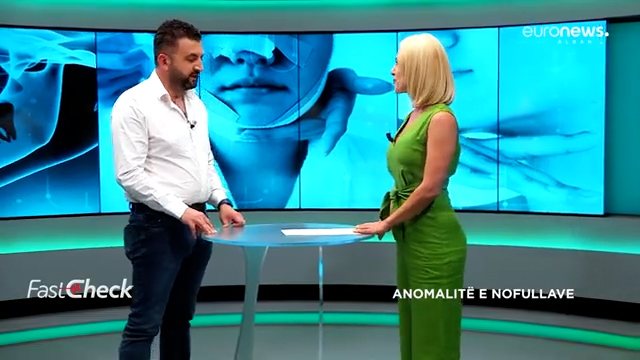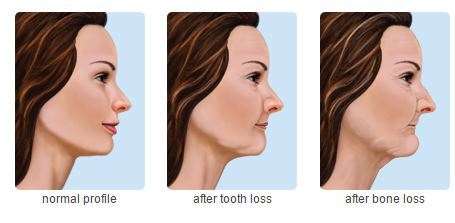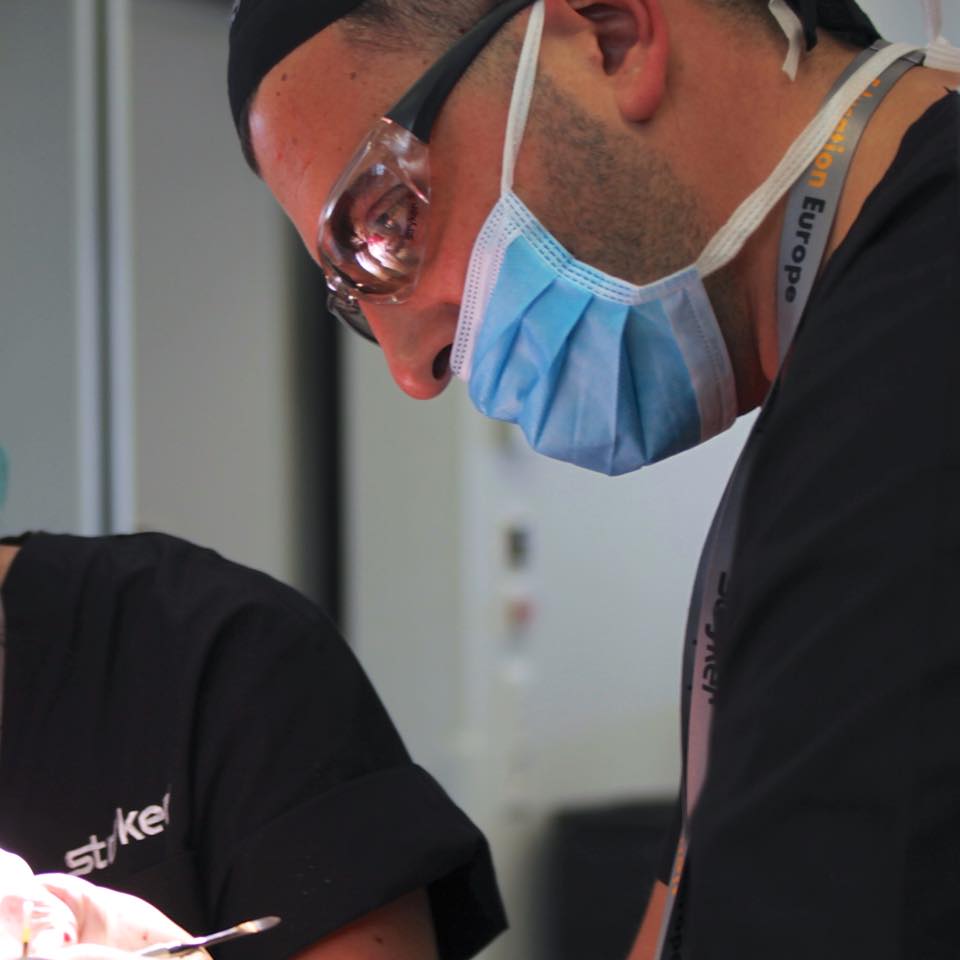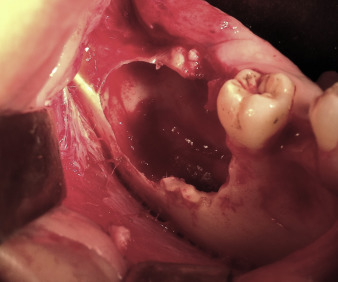Protezat e mbeshtetura mbi implantet dentare kane nje numer te madh avatazhesh ne krahasim me protezat klasike si me poshte
Pas heqjes se dhembeve ,humbja e kockes se nofullave eshte me ritme shume te shpejta.
Dhe ben qe te prishet dhe qendrueshmeria e protezave totale , megjithese keto proteza jane nje shkak qe e shtojne ritmin e humbjes kockore .
Por kush jane pasojat e humbjes kockore ne pacientet pa dhembe :
- Zvogelohet trashesia e kockes mbeshtetese.
- Zvogelohet lartesia e kockes mbeshtetese.
- Zvogelohet ne menyre progresive siperfaqja e mukozes se keratinizuar.
- Vendet e fiksimit te muskujve afrohen me kreshten e procesit alveolar.
- Levizje e protezave si pasoje e kontraktimit te muskujve mylohyoid dhe bucinator,te cilet sherbejne si mbeshtetje posteriore.
- Levizje perpara e protezes si pasoje e inklinimit anatomik.
- Hollim i mukozes
- Humbje e kockes bazale
- Ne disa raste humbja e kockes mund te coje deri ne parestezi qe vjen nga dehishienca e kanalit neurovaskulat mandibular.
- rriten levizjet e gjuhes gjate pertypjes
- Humbja e kockes con ne prishje te estetikes se katit te poshtem te fytyres .
Nga : Dr.Renato Isufi
Sot egzistojne menyra te shumta per te bere zevendesimin e dhembeve qe mungojne ne goje.
Menyra me e perdorur deri me sot eshte zevendesimi i dhembeve qe mungojne me Punime Protetike Fikse(Urat),dhe pas tyre vijne implantet.
Por kush jane avatazhet e Implanteve vs Urave:
Punimet Protetike Fikse (Urat):
- Nga studimet e bera vetem 50 % e punimeve protetike fikse qendrojne ne goje per me shume se 10 vjet.
- Duke qene se per te zevendesuar nje dhemb qe mungon do te perdoren dy dhembet fqinje , kariesi dentar tek dhembet fqinje eshte shkaku kryesor i deshtimit te ketyre punimeve.
- 80% e dhembeve fqinje qe do te perdoren per te mbajtur dhembin qe mungon , jane te paprekur ose kane restaurime minimale.
- Gjate pregatitjes se dhembeve fqinje per vendosjen e punimeve mund te lindi nevoja per trajtimin endodontik te ketyre dhembeve (heqjen e Nervit).
- Pas vendosjes se punimeve mund te kemi dhimbje ose rritje te ndjeshmerise tek dhembet ku eshte mbeshtetur ura.
- Jane te veshtire per tu pastruar ne siperfaqet aprksimale te tyre.
Avatazhet e Implanteve Dentare :
- Nga studimet ka rezultuar se 97% e implanteve dentare kane pasur jetegjatesi me te madhe se 10 vjet.
- Nuk shkaktojne demtim apo karies te dhembeve fqinje.
- Mund te pastrohen lehtesisht ne siperfaqen aproksimale (ndermjet dhembeve)
- Ruan lartesin kockore pas heqjes se dhembit
- Nuk jep dhimbja apo ndjeshmeri tek dhembet fqinje.
Nga : Dr.Renato Isufi
Studiuesit kane zbuluar se efekti i dy polyfenoleve te veres se kuqe ndihmon ne parandalimin e grumbullimit te bakterieve ne dhemb qe behen shkak per formimin e pllakes bakteriale tek dhembet
Dr.Renato Isufi
According to the ancient Egyptians and Greeks, it was: 1.6:1:0.6.
This is the “golden ratio,”a.k.a. the “golden mean,”the “golden section,” and the “divine proportion.” It is a proportional relation obtained by dividing a line, or a plane figure, so that the shorter part is to the longer part as the longer part is to the whole. If you take a “golden rectangle” — one whose length-to-breadth is in the golden ratio — and snip out a square, what remains is another, smaller golden rectangle. What makes the golden ratio special to mathematicians is the number of properties it possesses. But what makes it extraordinary to the world is its relation to beauty. The golden ratio has been evoked through the ages to express perfection.
Examples abound. The Egyptians called it the “sacred ratio,” and applied it to the building of the pyramids.
The Greeks used it in the construction of the Parthenon. It is said that daVinci painted the face of the Mona Lisa to fit inside a golden rectangle. People like the architect Corbusier and the composer Bartók have consciously embodied it in their work. And daily in art and science classrooms students discover that geometric forms expressing the golden ratio are simply the most appealing to the eye.
The entertaining BBC series “The Human Face,” tele- vised here two years ago, created a transparent template of an ideal face. Features and facial dimen- sions related to each other on the template in the ratio of 1.6:1:0.6. The template was trans- posed to the face of a beautiful actress. And lo, it fitted perfectly.
So beauty is 1.6:1:0.6.
That’s the easy answer. My own feeling is that we are in denial if we think beauty can be defined by a formula. Consider this story from my youth: I was a child in Brooklyn in the nineteen-fifties. All the ele- mentary school girls in my apartment house worshipped the glamorous Nelda, a woman who lived with her hus- band and a toy poodle in a one-bedroom apartment on the second floor.
She was our icon of beauty. Her long hair was an extraor- dinary color, a hitherto-unseen (by us) white gold known as “platinum,” while her eyebrows were tweezed to nothingness and replaced by a bold black pencil line. Her full lips were painted a glossy replica of the maroon Crayola in our boxes. She was voluptuous; she wore midriffs and shorts and three-inch-high cork-soled san- dals. By contrast our scarcely made-up mothers in their housedresses and flats seemed unbearably plain.
I could go on to tell you about the night a bat got into our building and somehow became enmeshed in Nelda’s pale hair. It is one of the cautionary tales of my childhood and explains why I docilely submitted thereafter to so many short haircuts. But I brought up Nelda to point out how time and change affect one’s perception of beauty. Within a few years Nelda’s looks lost their luster for me, as my esthetic world broadened beyond the neighborhood. I began to find her appearance silly, and eventually embar- rassing, as if my early adoration revealed something flawed in me. Nelda had stopped being beautiful to me, and it was not because she changed but because I did.
Background, conditioning, education, history, time, change. When we discuss beauty we bring all these to the table. At one time I believed that the phrase “form fol- lows function” perfectly expressed the American ideal of beauty. Coined originally by the architect Louis Sullivan as “form ever follows function” in an 1896 article in Lippincott’s Magazine and later embraced by the Bauhaus architects and designers who popularized the phrase in its shorter version, “form follows function,” it means that the function of a building or object deter- mines its form. And further, that the more it expresses its function, the more beautiful it is.
An example of this often cited (and worshipped) by architects concept is the famous Shaker round barn of Hancock, Massachusetts. Hay wagons entered the barn on its upper level, a railed wooden track around the inner perimeter of the building. As the wagons followed the track and circled the building, hay was pitched into the central area below. There waited the cows, facing the center, standing radially. Each wagon delivered its load and left the building by the same door it entered. The round form of the barn totally followed the function of hay pitching.
“Form follows function.” We think of the handles of our own precordless telephones, of well-balanced shears, of knives designed to fit the hands of surgeons and chefs, early sneakers, the first airplanes. Of the first big, square, bulky computers, testaments to their own complexity and unwieldiness. Were these beautiful, or simply possessed of organic reality? And when did it all start to change? Perhaps in Mike Nichols’ 1967 film The Graduate when someone looked young Dustin Hoffman in the eye, told him he had one thing to say to him, and uttered the word “Plastics.”
Perhaps it changed for me when I chose to bring an ele- gant olive green Olivetti typewriter to college with me, rather than the more reliable and chunky Smith-Corona. The Olivetti looked like a piece of art, the Smith-Corona looked like a typewriter. I needed the Olivetti to advertise that I was cool and artistic. Unfortunately, the Olivetti was also a piece of junk, or at least mine was, and I spent four years borrowing my roommates’ less splashy machines.
What is beauty? Industrial designers today certainly think WHAT IS BEAUTY?
they know. I turn to their work and I see: “cool” objects. Softened, biomorphic, futuristic, stunning, “cool” objects. Like Apple products — the candy-colored iMacs and iBooks, the recently revitalized iMac that sits like a pod on a stalk, the iPod music player. The curvy, reborn Volkswagon bug; the rounded, grooved, ultra-designed, candy-colored run- ning shoe. The cell phone, designed with many of the visu- al components of the running shoe. At the time of this writ- ing running shoes are still not able to take photographs. But is Louis Sullivan turning over in his grave as form moves away from function? Or is he laughing because our culture is adoring coolness and thinking it is beauty?
“What is beauty?” I ask a stylist friend. “Beauty today is what the fashion industry says it is,” she answers. If she is right then beauty today is indeed an ephemeral con- cept, since the fashion industry is constantly looking for a “new” face and ready to discard the “old” look it celebrated yesterday. But my friend has something to add: “In the last couple of decades,” she continues, “beauty has become a lot more unconventional.” I call to mind the fair-skinned, rigidly waved Breck shampoo ladies from the fashion magazines of my childhood, and I agree with her. Breck has morphed into Benetton and The Gap, the fair-skinned ladies into a many-hued, multiethnic coalition of young people with dazzling smiles. It occurs to me that those Breck ladies rarely smiled and never showed us their teeth.
Our ads also demonstrate that health and fitness (check those sparkling teeth) are an implicit part of beauty now, at least as the fashion world sees it. Indeed, our athletes, who exemplify fitness and once ignored fashion, today market and model their own lines of clothes. This pairing of fitness and beauty has led us to accept the idea of a man being described as beautiful. Men were not called beautiful when I was growing up unless there was something feminine about them. No one would argue today with a sentence like: “Boy, that Michael Jordan is a beautiful man!”
“The Human Face,” the BBC series I mentioned earlier, put an interesting spin on the fitness-beauty connection. It reminded us that symmetrical faces have always been perceived as more beautiful than asymmetrical ones and went on to say that British scientists have proven that ath- letes with the most symmetrical bodies are not only the most beautiful but the most gifted and successful. Yes, symmetry has long been considered a component of beauty. But it has its good and bad aspects. If we look at our own New York City architecture, we may be struck by the grace and elegance of our symmetrically winged City Hall. But nearby stands the monstrous Municipal Building, also symmetrically winged, a building that would not be out of place in Stalinist Russia.
What is beauty? As an artist, I ask myself this question all the time. I am chronically occupied with the creation of “beautiful” images, with representing, as Webster defines it, “the quality or…qualities in a person or thing that gives pleasure to the senses or pleasurably exalts the mind or spirit.” The poet Keats puts it a lovelier way: “A thing of beauty is a joy forever:/Its loveliness increases; it will never/Pass into nothingness…”
Thomas Mann, in his novel Joseph and His Brothers, has something somewhat sterner to say:
I confess that I do not care for talk about beauty. The word and the idea are alike tiresome. For beauty is a con- ception as pallid as it is lofty — a pedant’s dream. There are supposed to be laws of beauty. But a law addresses itself to the understanding and not to the emotions — for these do not brook the understanding’s control. Hence the vapidness of perfect beauty, which leaves nothing to be forgiven. For the emotions need something to forgive, else they turn away in sheer boredom.
Something to forgive. With this in mind I study the portraits by El Greco in his retrospective recently at the Metropolitan Museum. All are lauded as “psychological interpretations” of the sitters’ personali- ties. All are beautiful to me beyond belief, but none so much as “An Elderly Gentleman” and “Diego de Covarrubias,” both of which portray men whose mouths are just a bit off center.
Something to forgive. I like this phrase, when applied to beauty, because it is so unclassical, because it links beauty with feelings. I repeat it to my dentist. He gets it; he’s after “naturalness.” When creating a new mouth for someone, he says, he strives for some irregularity, “to subtly depart from a perfect arrange- ment of teeth.”
But can beauty be explained — or explained away — by a formula? What is beauty? Let’s look at modern literature. There’s an answer I like implicit in the description of my favorite J. D. Salinger character in his story “Down at the Dinghy”:
The swinging door opened from the dining room and Boo Boo Tannenbaum, the lady of the house, came into the kitchen. She was a small, almost hipless girl of twenty-five, with styleless, colorless, brittle hair pushed back behind her ears, which were very large. She was dressed in knee-length jeans, a black turtleneck pullover, and socks and loafers. Her joke of a name aside, her general unprettiness aside, she was — in terms of permanently memorable, immoderately perceptive, small-area faces — a stunning and final girl.
There is nothing about Boo Boo’s appearance that can be considered beautiful by fashionable or classical standards or by perceived notions of what is “cool.” One knows instinctively that no “golden ratio” will apply to her face. But Salinger makes a distinction here between inner and outer beauty, and has us believing that Boo Boo’s inner beauty is manifest enough for us to recognize it when we see her. Beauty fades, beauty passes, beauty is ephemeral. These are buzz phrases in our culture. We accept them so thoroughly that we are constantly saying, “She must have been a beauty once,” about lovely elderly women, as if beauty is something that applies only to the young. But faces like Boo Boo’s, or that of El Greco’s “Elderly Gentleman,” are beautiful forever. “Beauty is truth, truth beauty,” wrote Keats to end his Ode on a Grecian Urn. Truly beautiful faces express the truth about their wearers.
What is beauty? The debate inherent in the question will go on forever. We are bound to return again and again to the timeless simplicity of form following function, bound to be pulled away by our appetite for the new or the embellished. I end with a definition that may be applied to people or objects: Beauty is one’s inner reality expressed so authentically on one’s exterior that it takes the breath away. We see something whole, and we are awed. The experience is a revelation.
This article was reprinted without permission from Global Health Nexus, a publication of New York College of Dentistry.
Ne pergjithesi me kalimin e moshes kockat dhe kycet fillojne te japin shqetesime.Per kete aryse duhet te merren disa hapa te rendesishem si : Humbja e peshes ,ushtrimet fizike dhe te kaolohet kohe e mjaftueshme ne diell per te marre vitaminen K,e cila eshte shume e rendesishme per shendetin e kockave dhe ul ne menyre te ndjeshme shanset per zhvillimin e disa semundjeve si : Skleroza multiple , problemet e zemres dhe artriti reumatoid. Gjithashtu studimet e fundit e lidhin Vitaminen D edhe me permiresim te shendetit mendor .
Vitamina D mund te luaj nje rol te rendesishem per ecurine afatgjate te implanteve dentare .,sepse prezenca e saj ose mungesa e saj mund te ndikojne ne suksesin e integrimit te implantit ne kocke.
Gjithashtu Vitamina D ndihmon ne shendetin e midhrave te dhembeve ,ndihmon ne prodhimin e substancave qe reduktojne nivelin e bakterieve ne goje.
Dr.Renato Isufi
Kistat e nofullave paraqesin larmi ne shumellojshmerine e tyre
dhe ne vite i jane dhene emertime te ndryshme, duke u orientuar nga
indi, origjina, klinika, imazheria dhe histopatologjia.
Nje kist eshte nje kavitet patologjik, i veshur me epitel dhe qe
ka permbajtje likidi ose materiali gjysme solid. Ne mjekesi, “cyst” do te
thote thjesht “hapesire”.
Kistat jane mjaft te shpeshte ne regjionin O.M.F ,dhe njohja e
tyre ka rendesi sepse ne disa raste ata jane lezione destruktive.
Ne nofulla, kistat shfaqen si kavitete brenda kockes, te veshura
me epitel dhe permbajtje likidi seroz me ngjyre te verdhe ne kafe ne te
cilin shpesh hasen kristale kolesterine dhe elemente qelizore, te rrethuara
keto nga nje paret prej indi lidhor fi broz. Keto quhen edhe “kiste te
verteta”, per t’i dalluar nga ato kavitete kockore te cilat nuk kane veshje
te brendshme epiteliale dhe marrin emrin “pseudokista”.
Edhe ne ditet e sotme nuk ka nje klasifi kim unik persa i perket
kistave te nofullave, te kavitetit oral si dhe te indeve te buta te fytyres
dhe te qafes. Ne duke studiuar klasifi kime te autoreve te shumte, si
dhe mbeshtetur ne eksperiencen e shkolles tone do te mundohemi te
japim nje klasifi kim te permbledhur dhe te hasur me shume ne praktiken
klinike.
Pjesa me e madhe e kistave zbulohen rastesisht ne egzaminimiet
radiologjike te rutines. Megjithate, duhet dyshuar per nje kist te
nofullave kur:
1. Hasim ne nje tumefaksion te lemuar dhe shpesh te pa dhimbshem
gjate palpimit te nofulles.
2. Ne palpim konstatojme krepitacionin ose efektin ping-pong,
si pasoje e atrofi zimit te kockes nga rritja graduale e kavitetit kistik.
Gjithashtu ne palpim mund te ndjejme fl uktuacion, kur fl uktuacioni
ndjehet ne dy zona te ndryshme te nofulles,atehere mund te kemi kist
multilakunar ose edhe dy kista.
I pari autor qe u mor me studimin e kistave qe Bichat (1803) i cili
besonte se origjina e kistave duhet kerkuar ne origjinen e tumoreve te
tjera, duke i ndare nga njeri-tjetri vetem prej formes. Me vone Delpech
(1816), duke studiuar kistat radikulare, hodhi idene se kistat formohen
si rezultat i nje degjenerimi te tufes neuro-vaskulare te vete dhembit.
Autore te shumte pasuan, duke permendur ketu: Boyer (1818), Diday
(1839), MAGITOT (1874) etj. teorite e te cileve kane tashme vetem
vlera historike. Vijme keshtu tek Malassez (1885 – teoria e “mbetjeve
epiteliale paradontale”) teoria e te cilit, edhe sot eshte me e pranueshmja
persa i perket shpjegimit te origjines se veshjes epiteliale te vete
kistave. Ky autor, pasi mori ne studim nofulla pacientesh te cilet nuk
kishin formuar kista, zbuloi ne secilen prej tyre ato qe i quajti: debris
epithelieux paradentaires (mbetje epiteliale paradentare, mbetje te epiteleve
odontogjene) te cilat mbeteshin ne nofulla edhe pas formimit
te dhembit. Kistat e nofullave, ky autor i ndau ne baze te origjines dhe
raporteve topografi ke me dhembet:
1. Kista siperfaqesore subgingivare me prejardhje nga lamina
epiteliale e kordonit te organit te zmaltit te dhembit te qumeshtit;
2. Kista mediane qe zene te gjithe gjatesine e rrenjes dhe qe
kane prejardhje nga lamina epiteliale e kordonit te organit te zmaltit te
dhembit te perhershem;
3. Kista te thella te lokalizuara prane apeksit te rrenjes me prejardhje
nga mbetjet e organit te zmaltit te denticionit te perhershem.
Jane pikerisht keto te fundit, gjithmone sipas ketij autori, ato te cilat
jane pergjegjese per formimin e veshjes se kistave radikulare odontogjene.
Pervec mbetjeve epiteliale odontogjene, ekzistojne edhe
mbetje epiteliale nga formimi i fytyres gjate stadeve embrionale, epitel
qe vesh strukturat embrionale gjate shkrirjes se tyre dhe qe mbeten
ne linjat e shkrirjes. Meqenese keto linja perkojne me fi surat, ky epitel
merr edhe emrin epitel fi sural.
Ne qofte se Malassez zbardhi prejardhjen e veshjes epiteliale
te kistave, etiopatogjeneza e tyre edhe sot nuk eshte teresisht e qarte.
Mendimi i perbashket eshte qe kistat radikulare kane lidhje
direkte etiopatogjenetike me proceset infl amatore kronike me karakter
3. Mungesa e nje dhembi ne arkade ne paciente te rinj,sjell
dyshime per nje kist folikular; ne nje pacient te vjeter pas heqjes se
dhembit, per nje kist rezidual etj. Kistat folikulare zakonisht formohen
ne dhembet qe eruptojne me vonese si: molaret e pjekurise, kaninet
maksilare, premolaret e dyte etj
4. Nje lezion karioz masiv, dekolorim, frakture dhe mbushje masive
e nje dhembi ne qender te tumefaksionit, sygjeron nje kiste radikulare
5. Inklinimi i kurorave te dhembeve ne drejtime te ndryshme,
indikon pranine e nje kiste,gjithashtu kur pas heqjes se nje dhembi,
mund te kemi rrjedhje likidi kistik nga plaga, gje qe indikon pranine
e nje kiste, ose ne disa raste ne kista te lene pa trajtim me pranine e
fi stules ne te cilen here pas here rrjedh leng kistik
Kur kistat infektohen, tumefaksioni behet i dhimbshem.Ne raste
te rralla mund te ndodhin dhe fraktura patologjike te nofullave si rezultat
i traumave relativisht te lehta. Disa here mund te konstatohen
dhe raste te shfaqjes se parestezise si rezultat i zhvillimit ekspansiv te
kistes dhe i shtypjes se tufes neuro-vaskulare. Ne disa raste rritja e
kistes behet shkak per mos stabilitetin ose plage dekubitale te shkaktuara
nga protezet e levizshme te aplikuara prej vitesh.
Perveç imazherise, per venien e diagnoses se kistave sherben
anamneza, klinika, histopatologjia dhe disa egzaminime shtese si
punksioni probator, ekzaminimi bakteriologjik, elektrodiagnostiku per
matjen e vitalitetit te dhembeve etj.
Trajtimi i kistave varet nga permasat, regjioni dhe mosha e pacientit.
Menyrat me te perdorshme per trajtimin e kistave jane:
1. Marsupializimi (cistotomi): konsiston ne shnderrimin e kistes
ne nje kavitet “aneks” te gojes. Indikohet ne:
2. Ekstirpimi (heqja “in toto”) perdoret per kista te dimensioneve
te medha dhe ne keto raste mund te sillte demtime te strukturave
fqinje si: sinusi maksilar, dyshemene e gojes, tufa neuro-vaskulare e
qafes etj.
3. Per kistat ne femije: kur folikujt e dhembeve te perhershem
jane te spostuar nga presioni i kistes; pas nderhyrjes keta dhembe
mund te zene pozicionin e duhur ne arkade.
Ne rastet kur radiologjikisht ne kiste duken te perfshire nje numer
i madh dhembesh: per te evituar demtimin e paketit neurovascular
te tyre, ne keto raste, pas nderhyrjes, testohet periodikisht vitaliteti
i dhembeve.
4. Enukleimi dhe suturimi “per primam” (cistektomi): konsiston
ne heqjen “in toto” te sakusit kistik dhe te permbajtjes se tij.
Ka si avantazh:
• Mbylljen e shpejte te defektit
• Pacienti ka nje periudhe te qete post-operatore
• Kontrollet post-operatore nuk jane aq te shpeshta
• Monitorimi realizohet nepermjet radiografi ve per 6 muaj
per kistat e vogla dhe 1 vit per ato te medhate.


Patologjite e sinusit maksilar, shpesh ne praktike,
kerkojne vemendje dhe ekzaminime te sakta per te percaktuar
diagnozen dhe trajtimin korrekt te tyre.
Ne disa raste kerkohet nje konsulte e perbashket ndermjet
shume specialiteteve: kirurgjise maksilo-faciale, otorinolaringologut,
oftalmologut, imazheristit, neurokirurgut etj.
Ne mjaft raste, me te pa drejte, mund te behen trajtime apo
ekstraksone dhembesh nga stomatologu, shpesh duke u shtyre
nga kembengulja e pacientit per dhimbje nga dhembet e ashtuquajtur
sinusale.
Rruget me te mundshme te zhvillimit te nje sinuziti maksilar
jane:
• Rruga rinogjene: gripi, rinitet, infeksionet virale, anomali
anatomike si dhe patologji infl amatore te mukozes se hundes.
• Rruga hematogjene: semundje infektive apo gjendje septike
lokoregjionale apo sistemike.
• Rruga traumatike: fraktura te nofulles se siperme, kompleksit
zygomatik dhe hundes
• Rruga alergjike: te semure me alergji dhe kryesisht me probleme
te atopizmit stinor.
• Rruga odontogjene – Sinuziti maksilar odontogjen shkaktohet
me shpesh nga:
• Proceset infl amatore te molareve siper
• Kistat odontogjen te ketij regjioni
• Nderhyrjet operatore ne kete regjion
• Gjate mjekimt te kanaleve te molareve siper
• Gjate procedurave te venies se implanteve
• Pas osteotomive ne kirurgjine ortognatike
Ne mjaft raste ne praktike sinuzite jo-odontogjene shkaktojne
simptoma te ngjashme me patologjite e dhembeve te nofulles se
siperme nderkohe qe shpesh dhembet e kariuar me komplikacionet e
tyre mund te japin sinuzit, prandaj duhet treguar mjaft kujdes ne vendosjen
e diagnozes si dhe te realizohet diagnoza diferenciale midis
sinuzitit odontogjen dhe jo-odontogjen.
Simptoma kryesore e sinuzitit eshte dhimbja kryesisht pasdite,
qe perfshin gjysmen e kokes dhe e manifestuar ne dhembet maksilar
te kesaj ane. Dhimbja shtohet me levizjen apo tronditjen e kokes, si
dhe ne palpim ne fosen kanine apo te regjionit te tuber maksile. Kjo
dhimbje eshte e karakterit neuralgjik.
I semuri ka rrjedhje sekrecionesh nga hunda si dhe temperature
subfebrile.
Sinuziti odontogjen eshte unilateral dhe ne goje shikojme
dhembe te prishur, te hequr, rrenje apo alveolen bosh, si dhe ndonjehere
pranine e fi stules oro-sinuzale.
Sinuziti kronik ka nje klinike me pak te ngarkuar me: sekrecione
nga hunda me ere te rende, bllokim te saj dhe dhimbje e rendim te
kokes ne ate ane.
Bazohet ne anamneze, ekzaminimin klinik te pergjithshem dhe
ekzaminimin objektiv lokoregjional intra dhe ekstraoral.
Ne metodat diagnostike ndihmese imazheria me CT eshte
metoda me e mire per te vleresuar patologjite e sinusit maksilar sidomos
ne prerje transversale dhe koronale. Ne radiografi nje sinuzit akut
purulent duket me nje velature homogjene, ndersa ne format polipoze
ka nje velature jo homogjene.
Konsulta nderdisiplinore qe mund te rekomandohen jane: otorinolaringologjike,
alergologjike, stomatologjike, kirurgji maksilo-faciale.
Ne shume raste mund te ndihmoje punksioni probator i meatus
nasi inferior (trapanacioni).
Sinuziti akut trajtohet me antibiotiko- terapi afersisht 10-14 dite.
Antibiotiket me te perzgjedhur jane: amoksiciline, amoksiklav, co-trimoksazol,
cefuroksime, azitromicine, klaritromicine.
Sinuziti kronik trajtohet me antibiotiket e mesiperm per nje periudhe
tashme 1 muaj e gjysme, kortikosteroide spray, solucione hipertonike
per shperlarje te hundes, antialergjike dhe ne deshtim te terapise
perdoret mjekimi kirurgjikal.
Trajtimi kirurgjikal ne femijet e vegjel duhet te jete shume i
rezervuar sepse demtohen folikujt dentare dhe zonat e rritjes kockore.
Ne femije rekomandohet qe trajtimi kirurgjikal te behet me rruge endoskopike
transnazale ose te shtyhet deri ne perfundim te rritjes.
Per trajtimin e nje sinuziti orientohemi nga shkaktari, nga klinika,
nga anatomo-patologjia etj.
Teknikat kirurgjikale me te perdorura jane :
• F.E.S.S. (functional endoscopic sinus surgery) qe perdoret per
diagnostikim dhe trajtim
• Sinusektomia radikale sipas Caldwell-Luc, Denker dhe Jansen-
Horgan.
Nderhyrja kirurgjikale kryhet kryhesisht me anestezi te pergjithshme
por nuk perjashtohet dhe mundesia me anestezi lokale.
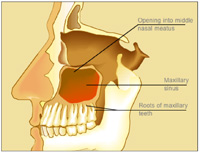
© Copyright 2018 – ISUFI ROYAL DENTAL. All rights reserved. Designed by EROL DIGITAL AGENCY. | Privacy Policy


